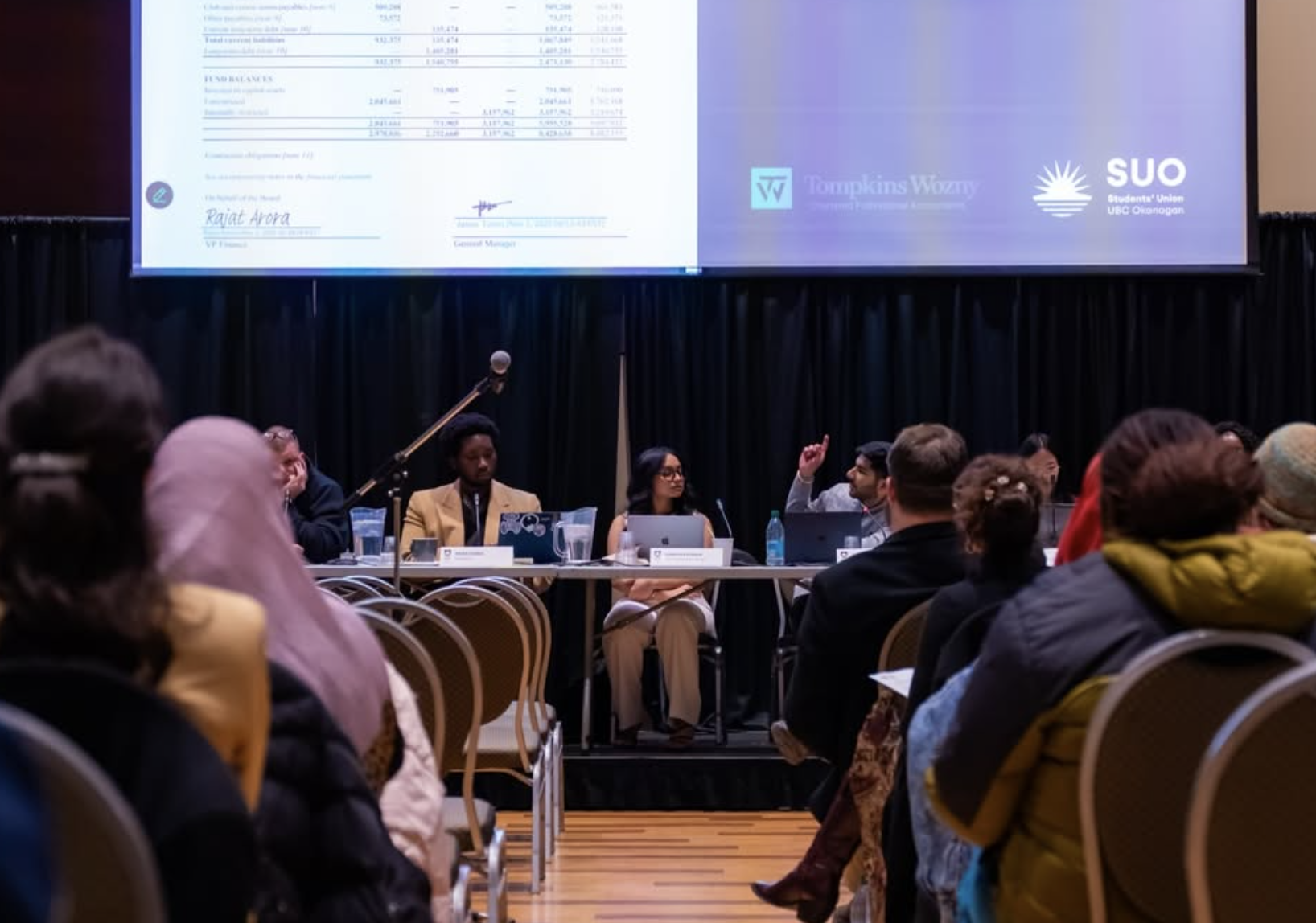
On December 3rd, I was able to interview Liz Blakeway, the Network Director of Land to Table Network of the North Okanagan (L2T) and Dr Mary Stockdale, a geography professor at UBCO and a founding member of L2T, on the recent food shortages in British Columbia due to the Vancouver storms at the end of Reading Week. The following is a summary of the in-depth conversation we had on the food shortages, the status and changes to Canadian and global food systems, and building food resiliency.
According to Blakeway, the food shortages we experienced mostly weeks ago was due to how our global food supply chains are structured. Our food supply runs on a “just in time” system of operation. This means that food deliveries are made in time for the restocking of grocery shelves, which means that there is little to no food storage in places like grocery stores. When the highways closed due to heavy damages from the storm, this meant that food distributors were no longer able to replenish their supplies, hence the bare shelves. Dr Stockdale added that the food supply chain was already a bit unstable, most notably seen with the onset of the pandemic, when Covid-19 induced labour shortages in food harvesting, processing or transporting began to emerge as a problem.

There is also a large geographical area over which food is processed. Liz notes that the milk produced in the Okanagan is taken by trucks down to the lower mainland to be processed and bottled and then brought back up to the Okanagan. This means that processing-wise, British Columbia is heavily reliant on transportation networks that stretch across the province, rather than local processing.
“There is nothing more absurd than having no milk on the shelves and then having dairy farmers in the same region pouring their milk down the drain” -Dr. Mary Stockdale.
According to Dr Stockdale, with the State of Emergency came the ability to mobilise funding, supplies and personnel to quickly deal with a situation, which otherwise would not have been possible. These actions may include setting up a centre to shelter evacuees, mobilizing food supplies, clothing etc, controlling the use of highways, and rationing gas. Usually, the declaration of states of emergencies are left up to the municipalities. However, BC found it apt to declare one in the aftermath of the storm.

State of Emergencies have become more common, as situations like Covid-19, the heat dome, forest fires, and now the storm have occurred more frequently. Though the highways are still under repair, Blakeway notes that the supply chains have shifted to come from Alberta, so the shelves have been restocked through that alternative route. This is also true for transport routes for processing. Perishable goods like milk are now able to be transported for processing in Alberta, thereby reducing the previous wastage. By the re-working of the food transport routes, Blakeway says the food shortages have mostly been solved in terms of what the consumers are exposed to. On the transportation side of things, Dr Stockdale at the time of the interview posited that there may be increases in food prices partly due to this rerouting, as Vancouver, which is a major port for North America, has experienced major damage to its highway which she estimated would not be repaired completely until the near end of December.
“We’re very vulnerable if we can’t get the raw milk to our consumers if we get blocked like this. We need to have more local self-sufficiency. We do have local farmers; we just aren’t always connected to them”- Dr Mary Stockdale
Food resiliency for Blakeway and Dr Stockdale is not about simply just replacing the current food systems, but also building a local food system. A local food system works internally within a region such as milk being collected and processed within the Okanagan. This contrasts against the global food system, which was mentioned previously, where processing, warehousing and distribution occur extra-regionally. Resilience is about having redundancy - the option of drawing from both the local and global food systems in order to always have food available and avoid future disasters locally and regionally. Dr Stockdale gave the example of if the Okanagan is hit with a drought, we would need the global food system, but in a case such as the storm, we would need the local food system, where food can be transported from nearby. Complete dependency of either may not account for all situations. Dr Stockdale urges that people be aware of these increasing instances of disruptions to our food system particularly with growing climate concerns, and cites the pandemic as a good example of how such disturbances play out, recalling the panic buying that occurred at the start of the Covid-19 lockdown.
“We have to turn from an efficiency mindset that economists always promote to a resiliency mindset.”- Dr Mary Stockdale.
When asked whether people are shifting to this resiliency mindset, Blakeway notes that local food is more expensive than global food because the global system has a way of externalising the environmental or social costs of food production in a way that does not happen locally, making local food more inaccessible. However, if all the food is the same price because of the higher costs previously spoken about, as well as the disruptions to global supply chains, hopefully, local food would be more competitive, accessible, and sought after. These local food networks have been heavily relied on especially in times of crisis, where grocers are now turning to local farmers for supplies and building and reinforcing those networks for future scenarios.

Dr Stockdale provides another good example of this as UBCO Food Services has started a pilot project in September in collaboration with L2T, where they bought a small amount of produce from local farmers as a trial, after they (UBC) were pushed by students to support local. During the recent shortages, L2T facilitated a meeting between UBC and the local farmers who were then able to provide them additional food as the global supply system was failing. Through the relationships created by the pilot project, UBC was able to draw on their partnership with local farmers in a time of crisis. When there was mention of the reduction in carbon footprint, Blakeway noted that there are huge amounts of food present in the Okanagan, but internal coordination is needed, which is the goal of L2T.
“You can’t necessarily always put all the onus on the consumer to purchase local food. Local food needs to be made available in the places where you are”- Liz Blakeway
Blakeway explained that The Land to Table Network of the North Okanagan is focused on bridging the gap between small, local farmers and larger institutions, through the rebuilding of actors in the middle such as food processors, warehousers and distributors. This will have the effect of making local food more accessible. According to Blakeway, L2T advocates for and helps facilitate connections that can make food available in your place where you study, work, in the hospitals, schools, senior care homes, etc. L2T’s goal is to act as a food system network coordinator, connecting all aspects of our food system to create a healthier, more coordinated, vibrant, and resilient food system.

L2T centres small to medium scale farmers who would not necessarily have access to other large markets. With the increasing average age of farmers being approximately 55 years, Dr Stockdale notes that the farmers need the support, especially as global food systems make small and medium scale farming less economically profitable, which means more farmers are retiring and fewer new ones are taking up those jobs.
L2T also works to carry out fundraisers, such as the Fire and Flood Recovery – OKIB Meat Drive which surpassed its target of $5000 through the help of donors, many of whom came from the UBCO academic community. This fundraiser aimed to help both members of the Okanagan Indian Band whose food security had been affected by the fires, as well as the farmers who were unable to feed their livestock over the winter due to unsuccessful feed crops as a result of the summer’s heat. The funds were used to pay the farmers for their meat, while replenishing the meat lost by the OKIB when their power, and therefore their freezers, failed this summer during the evacuation. L2T has been making huge strides in community and network building and has achieved many notable successes with the great work that they have been doing.
Dr. Stockdale is currently the professor for GEOG421 Food Systems, a course that delves deeply into many of the topics discussed in our conversation and this article. When asked about the major theme that she tries to drive home to her students, Dr. Stockdale emphasises the importance of a wide and holistic view of food systems. Food systems don’t solely include the consumer or the farmer, but it also encompasses distributors, transport networks, waste management, global, regional and local systems, politics, social factors, economics, and many more variables. We must see food systems as a whole because it allows us to see the gaps, strengths, and weaknesses of the system and the relationships between variables. Only then can we know what to change and improve.




